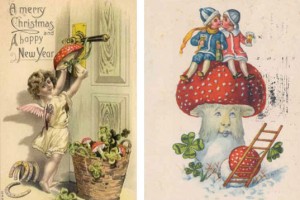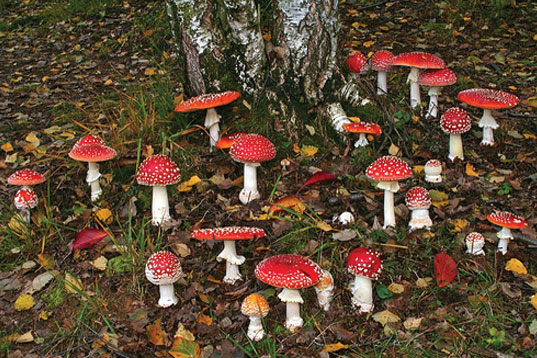Here is a “throw back Christmas” article on the mixing of two different myths about Santa. Enjoy!
Falling in the strange, but true category is the association of Christmas and a hallucinogenic mushroom called the Ananita muscaria (the holy Mushroom) or fly agaric. Collecting, preparing and using fly agaric mushrooms was part of winter solstice celebrations among many northern European and Asian peoples. According to anthropologist John Rush, “Santa is a modern counterpart of a shaman, who consumed mind-altering plants and fungi to commune with the spirit world.”
As the winter solstice approaches, fly agaric mushrooms appear under trees, mostly firs and spruces. As you can see, its cap is dark red, with small creamy-white patches. In central Asia, shamans wore special garments when they gathered the mushrooms—red coats and pants trimmed with white fur along with black boots. They would collect the mushrooms in a special sack. When they returned to the village, they would enter the dwellings through the smoke hole in the roof and share the mushrooms with the residents in a sacred ceremony.
The smoke hole was a gateway or portal into the spiritual world where the people would experience many visions. Among the Sami (Laplander) peoples, the hallucinations associated with ingestion of fly agaric gave the sensation of flying in a “spiritual sleigh” pulled by reindeer or horses (i.e., Santa in his sleigh journeying out into the night to give gifts).
There are those like Ronald Sutton, a history professor at the University of Bristol, who dispute the psychedelic Santa connection. He said his studies of Siberian shamanism showed they didn’t travel by sleigh; didn’t usually deal with reindeer spirits; rarely used mushrooms to have trances; and didn’t wear red and white clothes. Sutton believes that the Santa Claus known to us was invented by a New Yorker—Clement Clarke Moore—in 1822. Moore wrote the poem: “The Night Before Christmas.”
The more traditional “history” of Santa Claus is built upon the life of St. Nicholas, a fourth century Greek bishop. Nicholas became bishop of Myra, a small town in modern Turkey and was imprisoned for his faith during the “Great Persecution” of 303-311. One legend says he secretly gave money to a local nobleman who had three daughters with no money for their dowries. “He was going to have to sell them into prostitution because of his poverty.” “Father” Nicholas, as he was called, secretly gave him the money for the dowries on Christmas Eve. So began the custom of Christmas gift giving.
In 325, Nicholas, was one of the bishops invited to the Council of Nicea. It is said that he physically assaulted Arius at the Council because Arius suggested that Jesus was merely a man. Nicholas died and was buried in Myra, where his bones became venerated as relics, granting miracles and exuding a liquid they called ‘manna,’ that supposedly smelled like rosewater. Myra became a center for Christian pilgrimage and Nicholas became a saint.
In 1087 sailors from the Italian port city of Bari were hired by merchants to steal Nicholas’s bones and bring them back to Bari. Their aim was to build a basilica and make Bari a lucrative center for pilgrimage. The sailors were supposed to share in the profits, but the Church reneged on the contract and kept all the proceeds. The modern town of Bari still celebrates the sailors’ successful theft of Nicholas’s bones. Within the link “history of Santa Claus” is a BBC documentary sectioned into four YouTube videos that tells the story in more detail and includes a modern forensic reconstruction of what Nicholas would have looked like.
Nevertheless, the psychedelic Santa version of the myth continues, with even some suggestion that Moore himself adapted it for a modern audience in his poem. Watch this short YouTube video, Magic Mushrooms & Reindeer.” Fly agarics are also common images in many aspects of popular culture. They dance in Fantasia. Mario Brothers video game players eat them for power and extra energy. Here is a satire of Realistic Mario eating a mushroom. You can even buy fly agaric Christmas ornaments and cards, which have been traditional Christmas images in some northern European cultures.
Independent of the alleged Christmas connection, there is a clear history of humans using Ananita muscaria as a psychoactive substance. Its use in Siberia predates the Pleistocene migration across the Bering Straits into North America. After the migration, the use of fly agaric fell off in the Americas, as liberty cap mushrooms became “the preferred psychoactive fungi” because of their less severe side effects and more intense experiences.
The earliest suggestive evidence of Ananita muscaria use stems from linguistic analysis of languages from northern Asia. The Uralic languages from around 4,000 BCE contained root words for inebriation or intoxication that also signified the A. muscaria mushroom. Petroglyphs along the Pegtymel River in northeastern Siberia depict figures with mushrooms attached to their heads. There is a fresco in the Plaincourault Abbey in Indre France from 1291 AD that depicts Adam and Eve standing beside a Tree of Knowledge stylized as an Ananita muscaria. They use mushroom caps to cover their nakedness.

There has even been a theory put forth by John Marco Allegro in The Sacred Mushroom and the Cross that early Christian theology was derived from a fertility cult centered on the use of Ananita muscaria. Allegro argued that Jesus never existed; and that he was a mythical figure created by early Christians under the influence of psychoactive mushrooms. He said the Plaincourault fresco depicted “an accurate ingestion of Ananita muscaria as the Eucharist.” I could easily see the fresco as a stylized depiction of Adam and Eve eating something that would make them wise like God; but not his theory of Christianity and other religions originating as fertility cults. I think Allegro ate one too many mushrooms himself. At any rate, his theories were widely dismissed. His book was said to be: “possibly the single most ludicrous book on Jesus scholarship by a qualified academic.”
I don’t think we have to choose between these two Santa Claus legends, there seems to be enough room to accommodate both of them. But whether he was originally a shaman or a saint, Santa Claus has become an internationally known figure. Now if we could just get the ‘peace on earth’ part right.





